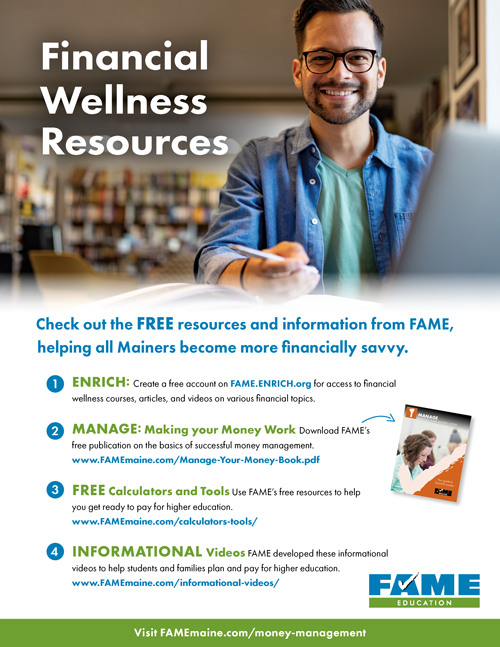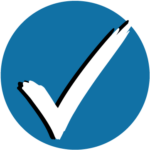An Employer’s Guide to Creating a Successful Financial Wellness Program
Whether you are a public or private employer, this roadmap will provide you with valuable information, resources, best practices, technical support, and research to guide the development and implementation of life changing financial wellness for your employees. A third of employees rank financial wellness programs as their top employee benefit, and studies show that employees want help with their finances but may be embarrassed to ask. A financial wellness program is an effective way to support your employees while helping your organization be more productive and successful.
Making the Case
During these challenging economic times, the need for financial education in Maine is more important than ever. Since the beginning of the pandemic, 63% of employees report that they are financially stressed and are more likely to have less income, difficulty meeting household expenses, and have postponed needed healthcare. They are twice as likely to tap into retirement accounts and use high-cost lending such as payday loans.1
Quick Facts: Maine2
- 54% of Mainers live paycheck-to-paycheck (36% break even and 18% spend more).
- 45% of Mainers do not have a rainy-day fund.
- 34% of Mainers with credit cards paid only the minimum on their credit cards during some months in the last year.
- Only 40% of Mainers can answer four or five questions on a basic five-question financial literacy quiz correctly.
Quick Facts: FAME
- In 2019, 54% of FAME employees reported that they spent an average of between one and two hours per week, while at work, worrying about money, or dealing with money-related issues, while 14% indicated they spent three hours or more.
- Financial coaching sessions made available to employees revealed:
- a significant number of employees who did not have a will or estate plan, while others had plans that were outdated. Cost and lack of time were cited as substantial barriers;
- ongoing financial stress for employees who were providing financial support to adult children and/or aging parents;
- an unexpected financial impact as a result of COVID-19. Several employees experienced a reduction in household income as a result of job loss among family members.
- While the economic downturn presents many challenges for FAME employees and the entire state, we believe that the Financial Wellness Roadmap will provide a model to assist other employers to adapt similar programs to improve their employees’ financial wellbeing.
Benefits of Establishing a Financial Wellness Program
Employee financial wellness programs help employees more effectively manage their finances while reducing financial stress. Quality programs will enhance financial wellbeing for employees overall, while increasing your organization’s success. Having more financially fit employees lowers absenteeism and reduces turnover while increasing employee satisfaction and improving employee retention and recruitment.
For the Employer
Employers are faced with many challenges. Financial stress impacts employees in a number of ways and their stress influences the success of your organization. Over 60% of Americans attribute their stress to money issues. Financial wellness programs increase productivity by addressing employee financial distress.3
Negative Effects for Financially Stressed Employees at Work:
Productivity
- 48% report being distracted at work (“presenteeism“)
- 46% spend three hours or more at work each week dealing with personal finance issues
- 20% spend five hours or more at work each week dealing with personal finance issues
- 31% say their productivity at work is impacted by financial worries
- 16% miss work occasionally due to financial issues (absenteeism)
Health and Relationships
- 35% indicate that their health was impacted by financial worries
- 32% report that relationships at home were impacted by financial worries
Cost to Your Organization
- Number of employees X 30% who are distracted = loss productivity! For an organization of 10,000 employees, that is $3.3 million lost per year
- Calculate your cost (click here and use the example on page 11)
Employees with the lowest levels of financial wellness cost employers an average of $94 to $198 per employee annually, according to the Optimizing Wellness Programs for a Diverse Workforce report published by the Financial Finesse.
For the Employee
Americans are financially stressed. Employers are in a unique position to help their employees’ financial wellness while improving workplace morale and performance. According to the Federal Reserve’s Report on the Economic Well-Being of U.S. Households in 2020, 44% of adults say they could not cover an emergency expense costing $400.
Advantages of Financial Wellness Programs to Your Employee Include:
- Provides employees with a greater understanding of money management such as creating a budget, managing and paying off debt, saving for a longterm goal like buying a home, or building a retirement.4
- Improved ability to build emergency savings – the savings rate increased dramatically during the pandemic but only those who held their jobs are able to save more.5
- Less stress and more focus on the job (overall wellness).
- Less sick time used due to handling financial problems.
- Better knowledge of how to leverage employer benefits to build a path to ontime retirement.
- Increased satisfaction with salary and benefit programs.
- Ensures that all employees have information to access appropriate financial products and services based on their unique needs and circumstances.
FAME Employee Wellness Program Overview
In 2019, FAME launched it’s first-ever employee financial wellness program. Led by FAME’s financial education program manager, the incentive-based program was developed using recognized best practices, as well as employee input and surveys.
Upon successful completion of the Employee Financial Wellness Program requirements, employees are eligible for an annual $250 financial wellness incentive, to be used for financial products and services or for an annual matched savings opportunity. Examples of financial products and services include:
- Purchase of tax preparation software or professional tax preparation services.
- Financial coaching, advising, or certified financial planning services.
- Professional and/or legal services for will and/or estate planning.
- Personal finance programs, DVDs, videos, books, and/or program memberships.
All FAME employees were invited to participate in the program. In the inaugural year, 67% of employees enrolled in the program.
RESULTS: FAME’s Employee Financial Wellness Program is an effective approach and increases the financial capability of participants.
Explore FAME’s Quantitative Research: Evaluation of FAME’s Employee Financial Wellness Program
Explore FAME’s Qualitative Research: Workplace Financial Wellness Program Evaluation
Financial Coaching
A financial coach is a trained professional who collaborates with and guides their clients to reach their financial goals. The process is personalized and non-judgmental. Financial coaches provide support, encouragement, accountability, and tools to help people make informed decisions.6
FAME offered one-on-one workplace financial coaching sessions three times throughout the year.
Find Coaches and Counselors
Association for Financial Counseling & Planning Education (AFCPE)
AFCPE® accredited financial counselors and coaches are now offering unbiased and fully confidential virtual financial counseling and coaching sessions – free to individuals and families who are struggling with the financial implications of COVID-19.
Find local certified financial planners who are available to provide professional advice in creating a financial roadmap. Whether you are seeking one-time advice or a more holistic life plan for your financial future, a CFP® professional is a trusted guide in the process.
Monthly Financial Education Workshops
Based on employee feedback, the following topics were offered:
Credit
- Credit scores and reports
- How and When to Freeze Credit
- Sandwich Generation
- Money Personality
- Estate Planning Essentials
- Reduce Credit and Debt
- Managing Debt
Spending and Saving Wisely
- Build Your Savings
- Physical Wellness and Financial Wellness
Investing
- Foundations of Investing
Retirement
- Planning for Retirement
- Social Security 101
Insurance
- Medicare 101
- Long Term Care and Asset Protection
Financing College
Home
- Value of Your Home
Self-Directed Online Financial Wellness
FAME provides employees, and all Maine people, with free access to Enrich, a proven digital financial wellness tool that improves financial behavior and decision making. Enrich data shows that employees who participate in the financial wellness program experience positive financial behavior changes7:
- 32% feel they are on track with their financial goals
- 28% pay off their credit card balance each month
- 27% created an emergency fund with three to six months of savings
- 15% contributed to their retirement plan
- 10% contributed enough to their 401(k) to get the employer match
The Path to a Successful Program
Key Steps
- Assessment
- Create an employee survey or conduct employee interviews or focus groups to determine employee needs.
- Evaluate and understand the key causes of employee financial stress, including any gaps in financial knowledge.
- Define program goals and measures of success
- Determine overall program goals and key milestones.
- Create a program evaluation plan and metrics, such as workshop attendance, courses completed, financial coaching outcomes, etc.
- Measure knowledge gain of participants and/or Financial Well-Being both before and after program participation.
- Scope
- Select size of program. Will you serve the entire organization or offer programming to specific employee groups?
- Ensure financial inclusion – consider target audience such as people of color, women, and the financially vulnerable populations.
- Select educational delivery method(s). For example, online tutorials/courses, website tools, classroom and webinar presentations, and one-on-one coaching.
- Determine program incentives.
- Timeline
- Determine the timeframe and length of program, including frequency of workshops and coaching sessions.
- Create a plan for onboarding new employees and determine eligibility for mid-year hires.
- Resources
- Secure endorsements from key leaders.
- Identify program champion(s), project managers, presenters, coaches, and vendors.
- Determine budget. Consider website enhancements, educational resources and tools, vendors, employee incentives, etc.
- Determine educational tools to be offered, including employee benefits, educational materials, digital platforms, workshops, etc.
- Consider developing a program agreement and policy for employees, including a disclosure statement that protects your organization from any financial decisions made by employees, such as any affiliations with presenters or outside experts.
- Create a presenter policy that requires presenters to share educational information only, and limits promotion or sale of specific products or services.
- Marketing
- Host an employee kickoff event.
- Send a letter or email to employees from leadership and champions inviting them to participate in the program.
- Create and deploy email blasts and reminders.
- Consider using posters, decorations, novelties, and contests to promote engagement.
Best Practice Tips for Employee Engagement:
- Conduct an employee survey – what do they want to know more about?
- Incentives work ($250 and a savings match or additional tuition, financial products, etc.)
- Organizational influencers – win over the key employee peer leaders and they will be your best friend in promoting the financial wellness program
- Top leadership – an endorsement of top leadership in the organization communicates the level of importance the program has to the organization.
- Participation should be perceived as an employee benefit, not a distraction from one’s job.
- Participate during a paid time – as an expectation, allowing employees to use work time to go through the program will result in the highest uptake and engagement.
- Allow for family and friends of employees to participate to encourage meaningful financial behavioral change.
- Provide financial coaching to help employees take the next personalized steps.
Financial Wellness Program Employee Engagement
- Know the Population Served
Financial education programs can be more effective if they are matched to people’s specific circumstances, challenges, and goals. Example: Start with an assessment tool, like the CFPB’s Financial Well-Being Scale. - Deliver Actionable, Relevant, and Timely Information
People are more likely to absorb information if it is connected to an upcoming decision that matters to them, at a time when they can put it to use, with concrete steps they can follow. Example: Provide first-time homebuyers with information they can use to guide them through the home loan process. - Build Practical Financial Skills
To put financial knowledge to use, consumers also need to build skills. Key skills include knowing when and how to find reliable information to make financial decisions, how to process the information, and how to follow through. Example: Give people simplified worksheets to help them comparison shop. - Build on Existing Motivation
Financial education can help people strengthen qualities and attitudes that allow them to stay motivated. You can help people focus on their own values rather than external influences, persevere in the face of obstacles, and build confidence that they can achieve their financial goals. Example: Set up a buddy system or financial coaching to help people stay on track. - Make it Easy to Make Good Decisions and Follow-Through
The situations people encounter can strongly influence what they actually do. You can help people follow through on their intentions by working with the influences or forces at play within their surroundings. Example: Help people set up automatic transactions that support specific goals.
Learn more about the CFPB’s Five Principals for Financial Education. Here is the link: https://www.consumerfinance.gov/data-research/research-reports/effectivefinancial-education-five-principles-and-how-use-them/
Resources
Resources to assist you when designing your financial wellness program.
- FAME offers Virtual Employee Resources for employers who wish to provide information about affording higher education to employees and their families at no cost.
- FAME has also created a series of informational videos on a variety of topics about affording education after high school
- MANAGE: Making Your Money Work: A free publication designed to provide valuable money management information to Maine people.
- FAME Tools & Calculators These tools were created to support students as they pursue education after high school, including higher education financing and financial wellness.
- Free online financial wellness at fame.enrich.org
- Maine Jump$tart Coalition for Personal Financial Literacy: FAME is a founding supporter of the Maine Jump$tart Coalition for Personal Financial Literacy, whose mission is to improve the financial knowledge of Maine citizens, with a special focus on pre-K through college students, including adult learners. The Coalition has compiled a number of resources through the Maine Financial Education Services Clearinghouse.
- Association for Financial Counseling & Planning Education: AFCPE® accredited financial counselors and coaches offer unbiased and fully confidential virtual financial counseling and coaching sessions – free to individuals and families who are struggling with the financial implications of COVID-19.
- Financial Planners (CFP): Find local certified financial planners who are available to provide professional advice in creating a financial roadmap. Whether you are seeking one-time advice or a more holistic life plan for your financial future, a CFP® professional is a trusted guide in the process.
- Financial Counselors (NFCC): Certified counselors are available to help with a plan to pay off debt, preserve or achieve homeownership, understand bankruptcy options, and offer financial tools and educational resources. They offer guidance about credit, debt, student loans, homeownership, mortgages, foreclosure prevention, bankruptcy, and small business ownership.
Technical Assistance
FAME is here for you.
FAME provides FREE resources and information, including online financial wellness courses and videos, to help Mainers become more financially savvy.
For technical assistance, please contact:
Mary Dyer, Financial Education Programs Manager, Finance Authority of Maine mdyer@famemaine.com or 207-620-3556
Mary can help employers with questions about:
- How to get started
- Strategies for selecting financial coaches
- Potential speakers for workplace virtual sessions
- EAP (Employee Assistance Program) – review your organization’s EAP program for internal support and potential financial coaching and counseling to augment your financial wellness program.
- Wellness Programing – be sure to connect existing wellness programing and resources to your efforts to assist employees holistically.
The Finance Authority of Maine (FAME) provides links to other websites as a convenience and does not endorse or guarantee the content accuracy or usability of such sites.
1 “2021 PwC Employee Financial Wellness Survey,” PwC, January 2022, https://www.pwc.com/us/en/services/consulting/business-transformation/library/employee-financial-wellness-survey.html
2 “National Financial Capability Study: Maine,” FINRA Investor Education Foundation, https://www.usfinancialcapability.org/results.php?region=ME
3 “Stress and decision-making during the pandemic,” American Psychological Association, October 26, 2021, https://www.apa.org/news/press/releases/stress/2021/october-decision-making
4 Mohney, Mary, “Financial Literacy Programs Improve Productivity, Performance,” Society for Human Resources Management, April 12, 2018, https://www.shrm.org/resourcesandtools/hr-topics/behavioralcompetencies/pages/financial-literacy-programs-improve-productivity-performance.aspx
5 Babson, Rick, “Study shows surge in savings during the pandemic,” Federal Reserve Bank of Kansas City, April 29, 2021, https://www.kansascityfed.org/ten/2021-spring-ten-magazine/study-shows-surge-in-savings-during-thepandemic/
6 “Financial Coaching,” Consumer Financial Protection Bureau, https://files.consumerfinance.gov/f/documents/102016_cfpb_Financial_Coaching_Strategy_to_Improve_Financial_Well-Being.pdf
7 “Is Financial Wellness a Must-Have Employee Benefit,” Enrich, March 15, 2021, https://www.enrich.org/blog/is-financial-wellness-a-must-have-employee-benefit





